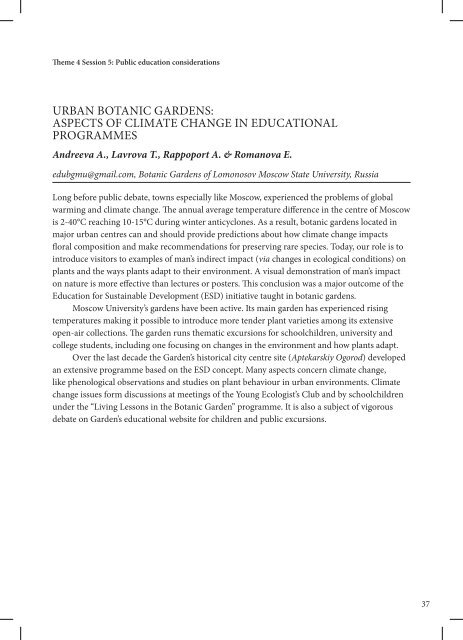Botanic gardens in the age of climate change - PlantNetwork
Botanic gardens in the age of climate change - PlantNetwork
Botanic gardens in the age of climate change - PlantNetwork
You also want an ePaper? Increase the reach of your titles
YUMPU automatically turns print PDFs into web optimized ePapers that Google loves.
Theme 4 Session 5: Public education considerations<br />
URBAN BOTANIC GARDENS:<br />
ASPECTS OF CLIMATE CHANGE IN EDUCATIONAL<br />
PROGRAMMES<br />
Andreeva А., Lavrova T., Rappoport А. & Romanova E.<br />
edubgmu@gmail.com, <strong>Botanic</strong> Gardens <strong>of</strong> Lomonosov Moscow State University, Russia<br />
Long before public debate, towns especially like Moscow, experienced <strong>the</strong> problems <strong>of</strong> global<br />
warm<strong>in</strong>g and <strong>climate</strong> <strong>change</strong>. The annual aver<strong>age</strong> temperature difference <strong>in</strong> <strong>the</strong> centre <strong>of</strong> Moscow<br />
is 2-40°C reach<strong>in</strong>g 10-15°C dur<strong>in</strong>g w<strong>in</strong>ter anticyclones. As a result, botanic <strong>gardens</strong> located <strong>in</strong><br />
major urban centres can and should provide predictions about how <strong>climate</strong> <strong>change</strong> impacts<br />
floral composition and make recommendations for preserv<strong>in</strong>g rare species. Today, our role is to<br />
<strong>in</strong>troduce visitors to examples <strong>of</strong> man’s <strong>in</strong>direct impact (via <strong>change</strong>s <strong>in</strong> ecological conditions) on<br />
plants and <strong>the</strong> ways plants adapt to <strong>the</strong>ir environment. A visual demonstration <strong>of</strong> man’s impact<br />
on nature is more effective than lectures or posters. This conclusion was a major outcome <strong>of</strong> <strong>the</strong><br />
Education for Susta<strong>in</strong>able Development (ESD) <strong>in</strong>itiative taught <strong>in</strong> botanic <strong>gardens</strong>.<br />
Moscow University’s <strong>gardens</strong> have been active. Its ma<strong>in</strong> garden has experienced ris<strong>in</strong>g<br />
temperatures mak<strong>in</strong>g it possible to <strong>in</strong>troduce more tender plant varieties among its extensive<br />
open-air collections. The garden runs <strong>the</strong>matic excursions for schoolchildren, university and<br />
college students, <strong>in</strong>clud<strong>in</strong>g one focus<strong>in</strong>g on <strong>change</strong>s <strong>in</strong> <strong>the</strong> environment and how plants adapt.<br />
Over <strong>the</strong> last decade <strong>the</strong> Garden’s historical city centre site (Aptekarskiy Ogorod) developed<br />
an extensive programme based on <strong>the</strong> ESD concept. Many aspects concern <strong>climate</strong> <strong>change</strong>,<br />
like phenological observations and studies on plant behaviour <strong>in</strong> urban environments. Climate<br />
<strong>change</strong> issues form discussions at meet<strong>in</strong>gs <strong>of</strong> <strong>the</strong> Young Ecologist’s Club and by schoolchildren<br />
under <strong>the</strong> “Liv<strong>in</strong>g Lessons <strong>in</strong> <strong>the</strong> <strong>Botanic</strong> Garden” programme. It is also a subject <strong>of</strong> vigorous<br />
debate on Garden’s educational website for children and public excursions.<br />
37





